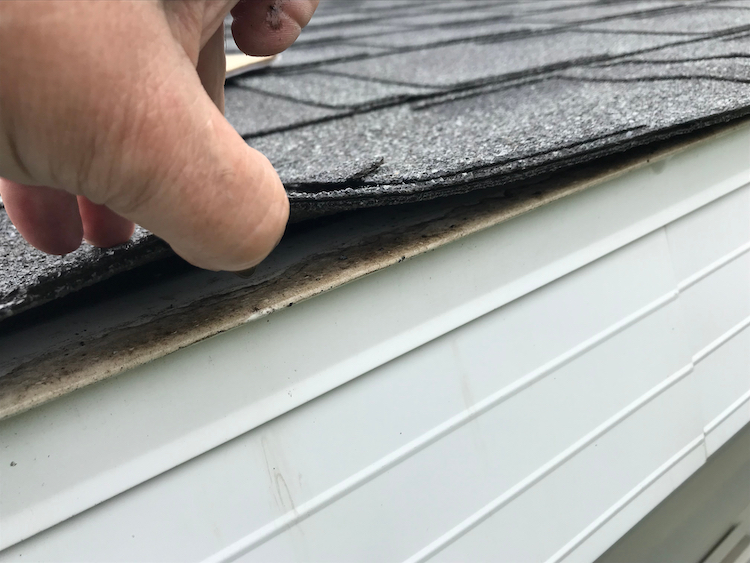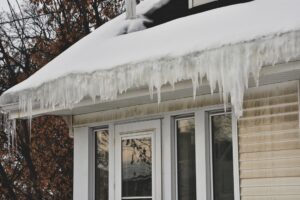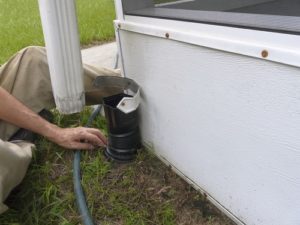
If you have an asphalt roof and a half-round gutter system on your home then you’ve probably noticed tiny roof granules that wash out of the downspouts or collect inside of the gutters. Granules on an asphalt shingle roof loosen over time and, as a result, pass through the gutter system.
Homeowners often worry when they notice shingle sediment wash out of the gutter system. Is there an issue with the roof? Does the roof need to be replaced? Should I contact a gutter installation company? These are common thoughts homeowners have when they notice shingle sediment in their gutters. Luckily, finding roof sediment doesn’t always mean a major issue, but it is important to keep an eye on it. Continue reading to learn about some possible reasons why you’re spotting shingle sediment in your half-round gutters.
Your Roof is Older
An older roof shedding shingle sediment may indicate an issue. Every roof will need to be replaced at some point. Unfortunately, asphalt shingle roofs have an average lifespan of about fifteen years, so if your roof is approaching its 15th birthday then it may be time to replace it soon. Each asphalt shingle will naturally deteriorate over time as a result of severe weather and precipitation, causing those many layers of granules to fall off little by little until there’s not much left to protect the base layer.
The age of a roof isn’t a precise factor in determining if a roof needs to be replaced. Other factors come into play like the roofing material, condition of the roof/shingles, when the roof was installed, and weather conditions. Living in Colorado means we experience a lot of winter precipitation and severe weather which can cause a roof to age quicker. Keep an eye on shingle sediment that falls from your older roof and contact a roofing professional if you notice an increased amount.
Your Roof is Fairly New
If your asphalt shingle roof is fairly new and you’re noticing shingle sediment around your gutters then you’re probably wondering how there’s an issue with the roof this soon. Surprisingly, a new asphalt shingle roof will almost always shed shingle sediment. If it was installed by a reputable roofing installation company then you probably have nothing to worry about. Why is it shedding shingle sediment so soon?
An asphalt shingle roof consists of many shingles that have several layers. Each layer of the shingle contains a bunch of layers of granules that help protect the base layer of the shingle which is usually made of fiberglass. The layers of granules that cover the base material help protect the base layer from leaks and damage. New asphalt shingles will shed granules for several reasons: becoming loose from installers walking on them during the installation process, first rains, or severe weather. Each time it rains, tiny granules that shed from each shingle will wash out through the gutter system. Again, it’s not usually a cause for concern with a new roof and it’s to be expected. If you’re concerned then it’s best to contact the company that installed your new roof to inspect it for damage.
Extreme Weather Conditions
As we previously mentioned, severe weather can wreak havoc on asphalt shingles. Living in Colorado means we experience our fair share of extreme weather conditions like blizzards, high wind gusts, and severe thunderstorms that bring hail. All of these extreme weather conditions can cause your asphalt shingle roof to age quickly, resulting in shingle sediment to shed from the shingles.
Roofs exist to protect the interior of our homes from the elements, however, weather patterns will cause roofs to deteriorate over time. Whether they’re covered by snow or ice or being pelted by hail during a thunderstorm, granules on an asphalt shingle roof will loosen over time. Depending on the severity of the storm, it may be best to contact your homeowners insurance to inspect your roof for damage. If your roof is covered by a warranty then you may want to contact the roofing company that installed it to inspect and repair the damage. Having your roof inspected for damage following a severe storm is better than letting it go which can result in more damage over time.
Discovering shingle sediment in your gutters doesn’t mean it needs to be replaced immediately. While it can be normal to discover shingle sediment if your roof is new, sometimes severe weather and an aging roof can be a cause for concern. Again, it’s best to contact a roofing specialist if you’re noticing large amounts of tiny granules being flushed out of your gutter system.
Unfortunately, if you have excess amounts of shingle sediment that’s shedding from your roof it could cause issues for your gutter system. Half-round and sectional gutter systems can clog easily especially if debris like roof granules collects and builds up over time. Depending on how long your roof has been shedding shingle sediment, there could be a large amount of it collected in the gutters and downspouts. Shingle sediment weights more than water and if it remains inside of a gutter system then it can create a clog resulting in all sorts of issues like overflowing gutters, sagging gutters, possible damage to the soffit and fascia boards, foundation damage, and it can even cause more damage to your roof.
Cleaning your half-round gutter system is paramount when it comes to protecting it from clogs that can result in these issues. How often you need to clean your gutters depends on a few things like the trees that surround your property and weather conditions. As a general rule of thumb, clean your half-round gutter system at least two times per year. If you have pine trees that surround your home then you may need to clean your gutters more often.
Say goodbye to cleaning your gutters forever by installing the K-Guard Leaf Free Gutter System. Our product, when compared to a traditional gutter system, has a curved hood that eliminates the possibility of leaves and other debris from entering the system, therefore eliminating clogs for good. The K-Guard Leaf Free Gutter System is also seamless, unlike sectional gutters that trap debris and cause clogs.
To install the K-Guard Leaf Free Gutter System, contact our team of professionals today. K-Guard is the premiere gutter company in Colorado, providing a leaf-free gutter solution for homeowners for many years. We proudly install the K-Guard Gutter System across the state of Colorado including, but not limited to, the following locations: Denver, Colorado Springs, Littleton, Centennial, Aurora, Boulder, and Fort Collins. Schedule your free estimate today!



